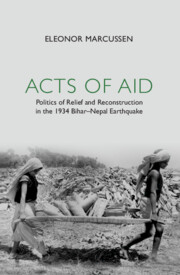Book contents
- Frontmatter
- Contents
- List of Illustrations
- List of Tables
- Acknowledgements
- List of Abbreviations
- Note on Transliteration
- 1 Introduction: Experiencing the Extraordinary and the Ordinary
- 2 Responses and Responsibilities in Emergency Relief
- 3 From Local to National Politics of Relief
- 4 Colonial Relations in Aid
- 5 Categories of Victims
- 6 Congested and Contested Spaces
- 7 Conclusion
- Glossary
- Bibliography
- Index
4 - Colonial Relations in Aid
Published online by Cambridge University Press: 13 January 2023
- Frontmatter
- Contents
- List of Illustrations
- List of Tables
- Acknowledgements
- List of Abbreviations
- Note on Transliteration
- 1 Introduction: Experiencing the Extraordinary and the Ordinary
- 2 Responses and Responsibilities in Emergency Relief
- 3 From Local to National Politics of Relief
- 4 Colonial Relations in Aid
- 5 Categories of Victims
- 6 Congested and Contested Spaces
- 7 Conclusion
- Glossary
- Bibliography
- Index
Summary
In faith and hope the world will disagree, But all mankind’s concern is charity.
Introduction: The Viceroy’s Earthquake Relief Fund and ‘State-Aided’ Charity
After having discussed the ways in which political agendas and local, regional and national networks shaped the organisation of relief funds and relief associations, this chapter examines the colonial government’s position towards charitable relief and the role of so-called colonial, imperial or state-aided relief funds as a part of the government’s relief and rehabilitation response. The colonial government indirectly or directly controlled these funds created with the purpose of providing the main source of funding for charitable relief and managed to collect a large amount by relying on networks surrounding elites, the government administration and emerging institutionalised international cooperation.
The colonial government played a central role in collecting public charity by facilitating collections of the Viceroy’s Earthquake Relief Fund (VERF), founded by the Viceroy and Governor-General of India after the earthquake. It is interesting to note in this context that although Lady Countess of Willingdon first intended to organise a relief fund, it was her husband the Viceroy who became the fund’s front figure. At the time of the earthquake the couple was about to leave Calcutta from Howrah station and Lady Willingdon remarked ‘Well, we left Madras in a cyclone, and now we leave Calcutta during an earthquake.’ In India the VERF received public subscriptions and collections organised by government officials. The Governor of Bihar and Orissa, James Sifton, soon followed the Viceroy’s announcement with a speech and appeal for the fund, and diverted the provincial relief fund under him to the VERF. In London a Mansion House fund collected international subscriptions on behalf of the VERF. In addition to using established networks in order to collect charity, the government managed to pool funds into the VERF from two other large fund collections—a collection made in an international appeal by the International Relief Union and by the Mayor of Calcutta, Santosh Kumar Basu, for the Mayor’s Earthquake Relief Fund, commonly referred to as the Mayor of Calcutta’s fund.
- Type
- Chapter
- Information
- Acts of AidPolitics of Relief and Reconstruction in the 1934 Bihar–Nepal Earthquake, pp. 155 - 191Publisher: Cambridge University PressPrint publication year: 2023
- Creative Commons
- This content is Open Access and distributed under the terms of the Creative Commons Attribution licence CC-BY-NC 4.0 https://creativecommons.org/cclicenses/



